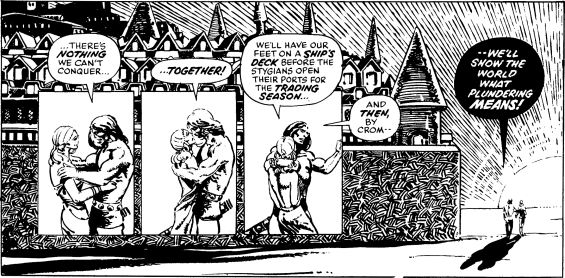The faerie tradition that goes through 16th century Spenser (with a side-step to Byron) and then 30s Weird Tales, to arrive at Noto’s Red Sonja, is rich in classical allusions. While Howard was no classicist, it can’t be denied that Red Nails takes its subterranean atmosphere and material from Knossos as well as the familiar Aztec allusions.
Noto’s affinity with Faerie Queene has already been noted – the “scarlet-bound demons, neither male nor female” (see Canto 1, 21 Aspects 1). Classically, there is a myth that Venus spends 6 months of the year with Vulcan in his demonic red forges. Vulcan won Venus by sleight of hand but had to forego her annual affections as a girl’s got to have some fun.
Noto’s “Red Lace” (Aspects 3) could be read as Red Venus in a sea of crimson blood. The story turns on fastidious workmanship by, for instance, the Centaur who blows gems that later hatch rocs; Sonja’s blood-bubble bath.. and others. That reading is forge-like, as the classical Vulcan was known for his objets d’arts.
There is also more than the hint of decadence in the weird tree-growth and violent violet plants that lust for blood. Greek myths quite often have an association of opposites. Maybe sometimes it’s a joke, as when Venus is cooped-up in Vulcan’s dismal din-laden domain.
The meaning of decadence in a sea of blood is pretty transparent, though, hinting at death and regeneration as with the myth of Proserpine, wife of Pluto, who spends 6 months with her mother Ceres (spring).
So, when the ego-monsters, in their labyrinth of formulaic ritual, cry “folly” to the id, they are neglecting the vast domain of Pluto and Proserpine, of death and rebirth, decadence, blood and lust as opposed to cerebral musings. The ego-monsters – as noted - cannot conceive of opposites as they live in the labyrinth of straight-line articulation. Anything that hints of decadence, twilight, subterranean gloom let alone blood lust is pure folly. The exact opposite is true in Greek myth.
Knossos, the palace-city of subterranean twilight and the Minotaur, is also the home of gay Minoan frescoes, bull-dancing and the great bronze bull built by Daedalus. Orpheus dances gaily into the underworld, charming grotesque dog-headed Cerberus with his lyre-playing. Howard’s berserker mentality is akin to this if you think of it as a type of dancing with death, carefree in the face of the gloomy caverns of timelost feuds
 Red Nails, Savage Tales #3
Red Nails, Savage Tales #3
If you think of that position as a type of realism, since everyone dies, the modern view is actually completely unreal! To Nietzsche, the Apollonian vision was never reality, as reality is lusts and the urge for blood (I mean that in a loving way). The modern vison is for life without death, almost life without dirt since it tends to be sterile (infertile). There’s a quote from Joel Grey, who plays the EMCEE in Cabaret I caught on the DVD commentary: he’s wearing an old German uniform and he says, “Their idea of hygiene was very different from ours.”
Yes, because dirt, sweat, blood, toil are born of decadence. The peasants of Bruegel dance for the seasons, for the loam of the soil. The world of dirt and degradation is neglected by the modern vison because it can only contemplate sterile life which is actually infertile.
What they call folly is what you find in Greek myth; which is that the underworld - or Vulcan’s noisome, stench-laden domain - are powerhouses for regeneration and creativity. This entire aspect of blood and toil, sweat and death is completely absent from modernity. In “their” future death will exist as a concept, not as a reality.
The reality is a vast underworld of cyclical regeneration that is personified in the myth of Proserpine (also Daphne and Apollo). What Greek myth shows is that life and death are part of one thing, which is fertility. Dionysian gaiety, the peasant dance, happiness in sensuality.
The voluptuous description in Spenser’s Faerie Queene are from that same area. The descriptions of sensual allure that render visible its opposite, the labyrinthine foulness of the dragon’s lair (Aspects 1)
Huge heapes of mudd he leaves, wherein there breed
Ten thousand kindes of creatures, partly male
And partly female of his fruitfull seed;
Such ugly monstrous shapes elsewhere may no man reed. Canto 1, 21
These unconscious images of repellence are probably echoed in Lovecraft (1930s Weird Tales) where vast, slithering, unwordly forms of repellence well-up from the pre-modern instinct. The unconscious images are rendered visible by a sensual allure which Lovecraft shared with Howard. The sensual reveals its opposite, which in Howard is the world-devouring Thoth Amon, wizard of Stygia.
Voluptuous sensuality in this sense has a cleansing effect and – as in the reading of Noto’s “Red Lace” – allows for the pure spirit (the knight in Faerie Queene).
This reality corresponds quite well with Jean Jacques Rousseau’s happiness in the bosom of nature. Similar readings are found in Noto’s “Red Lace”, with the voluptuous imagery along with dragon-forms like the scarlet-bound demons, “neither male nor female.” So, voluptuous sensuality in the bosom of nature reveals its opposite, by virtue of contrast, to be what it is: the beast of foulness personified. I know that sounds like apocalyptic language, probably because unconscious instinctive imagery is always going to have similarities.
Why am I being so melodramatic, you ask? Because I have come to realize that a sterile world has no content. What is content? It is the unconscious, which reflects the bosom of nature, and the bosom of nature is dark and ageless. The darkness comes from the power of decadence – Artemis of the moon. From that comes fertility and voluptuous nature, marvellous symmetry and balance. Dionysian rhythms.
The sensual cycle encompasses dirt and decadence, a cleansing of body and spirit through gaiety and orgiastic ritual. A sterile world has none of these voluptuous rhythms, and instead harbours the filth of foulness in the dragon-form of ego-monsters. I know you’ll have trouble with this language! I was reading a review of Arcade Fire’s Everything Now, and he says, “The results are dazzling, baffling, absurd and discombobulating, all at the same time.. everything you could hope for”.
Excuse me? I would say that’s a definition of lack of content. No blame on Arcade Fire; the blame is in the world they live in that denies the red instinct of Dionysus. If you want voluptuous rhythm and a strangely Hispanic sense of ageless content, here’s Grace Slick’s Manhole The Movie (all 13 minutes).
MANHOLE THE MOVIE
These lyrics have content, metaphorizing nature in a Shakespearean sense (King Lear and the demented storm). An epic of natural force. In reference to her paintings, Slick says they are “strong, blunt, simple as rock” (They rock). That is content, the rhythms are powerful and you are swept away.
It is because we live in a labyrinthine world that the rhythms of voluptuous nature don’t get to us, and we are sterilized. The rhythms that wash away impurities. That is a type of freedom we are denied as they lock us up in an inert world where cyclical powers are sapped; one resembling the maze of the Minotaur, where “the echoes through these winding passages could change and transform any sound.” (Myths of Ancient Greece, Emile Genest, Burke 1963).
Replication, transformation, confusion. We who are cut-off from the strong, simple rhythms, the gay symmetries that intoxify, the Mistral that cleanses as it blows, “He wants to run, Give him the sun”.
NEXT: THERE WILL BE DRAGONS..
Home







